The Choice You Finish With
There can be no doubt that finishing is an art form and gaining mastery in the application of the different types takes time. That said, manufacturers have gone to great lengths to give us products that ease the process. No one should be afraid of ruining their great and labour-intensive project by the finish any more. The finishes given below are the simplest of all to apply and give professional results. I use them all the time.
I doubt that I have used every finish on the market these days as there are so many to choose from but I have narrowed down my preferences to three I like and for good reason. Through the decades I have relied mainly on the all-natural finish known as shellac because of its universal safety as a product, its ease of application and its durability for indoor furniture use. Take some secretion from the lac bug, soften and dilute the excrecia down with denatured alcohol, and you can give depth and shine to everything from furniture to fingernails and, yes, even candies almost always get their shine from shellac. Denatured alcohol will remove it, restore it, thin it and repair it. You can colour it, apply it with a cloth, brush it on and spray it to a flawless finish too. What is there not to like about it? Well, not everyone wants a high-gloss finish and some want a finish that does not dissolve when they spill the spirit alcoholic drink on it. Even so, it will always remain a faithful favourite for some of my work. For ease, simplicity, quickness and low cost, I usually brush on shellac to encourage others and show how easy it is to work with. I have also found it to be one of the best ways to learn and master brushing on all types of brush-applied finishes too, to work out how best to load the brush, how to direct the brush strokes in any given work and project and things like that that only really come by doing.
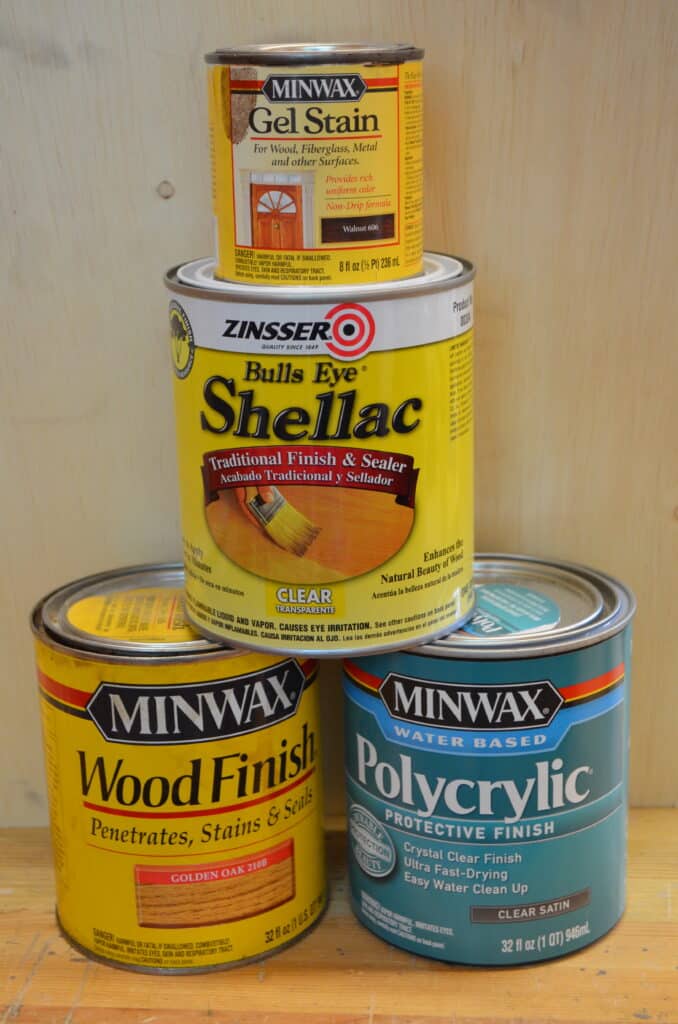
Cross-brushing and feathering out the brush strokes along the grain is quick and effective and you can ‘feel’ the finish as you apply it. By ‘feel’ I mean to sense the drag on the brush as the denatured alcohol in the finish evaporates. It takes only a few seconds to get to this stage and you will feel the surface ‘pull‘ as you pull the brush along the surface and this is the point where you lift off and leave the finish alone. You don’t get that with other finishes. Each level of application with shellac melds into and with the previous coats so applying five coats or whatever ends up as a single thick coat. You must work more quickly with shellac than any other brush- or rag-applied finish. This is a good thing as it demands quick thinking and action. You apply along the grain first, stretch out the finish, cross-brush to even out the application, and then pull long strokes with the grain to feather out the finish as even in thickness as possible. We do this with all solvent-based brush-applied finishes but this finish gives you the feedback other finishes do not because of their extended open or curing time which is usually hours and not seconds and in some circumstances split seconds.
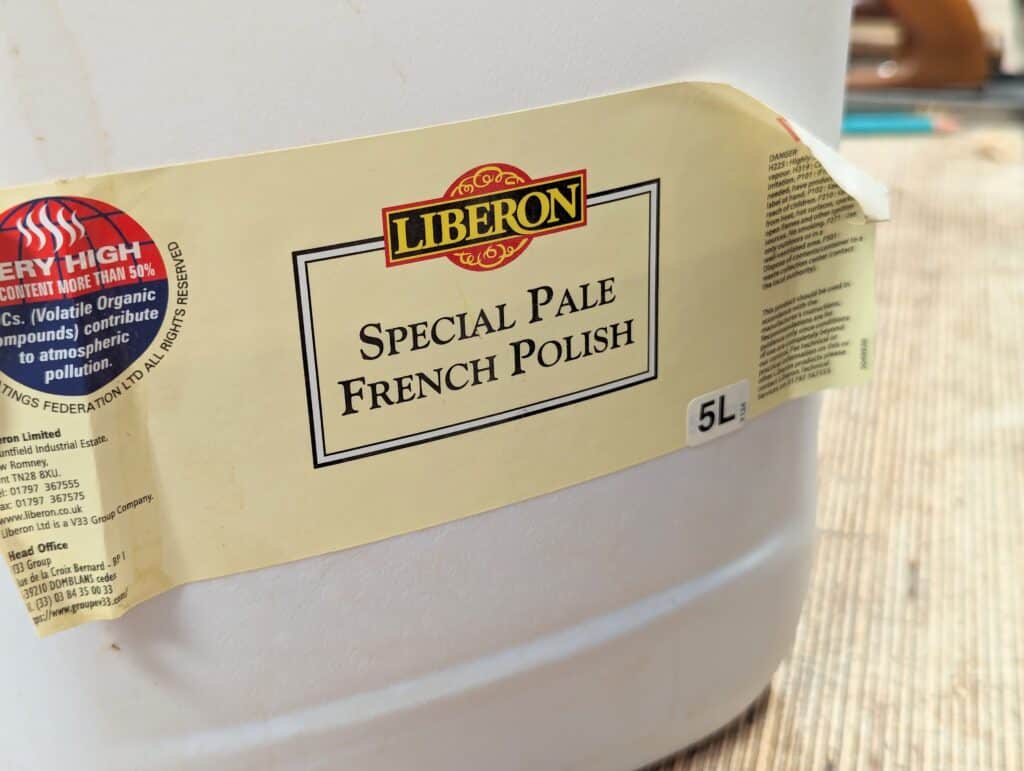
Shellac is also very sprayable and especially so with an HVLP (high-velocity low pressure) sprayer. This type of spray rig delivers precise amounts in tight bands to the material you are spraying. The width of spray can be easily and readily controlled by the twist of the nozzle as can the amount being sprayed with a similar twist action directly behind the spray head and trigger mechanism of the gun. Spraying several coats is possible with just seconds or minutes between coats. Allowing time to dry between them reduces any risk of softening and sagging surfaces. On any given project you can usually spray several thin coats in say fifteen minutes. Thin coats dry quickly because the denatured alcohol evaporates so quickly. It’s seconds to a touch-dry readiness so in that time you have a finished surface that needs no more work. You must practice using an HVLP sprayer, learning to switch from vertical to horizontal mode between actions that need the change. A great way to practice is on fence painting or low-grade jobs. HVLP spray rigs are quite expensive, hence my general showing of brush applying it.
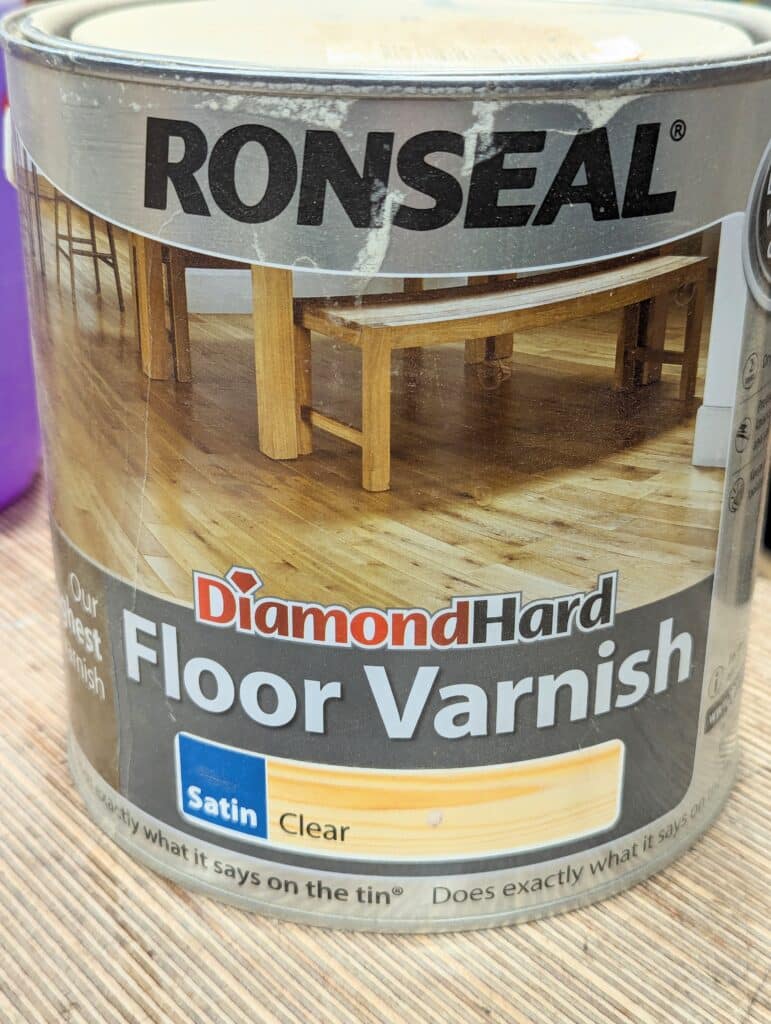
Another finish I have used and still do is waterbourne acrylic lacquer but I use it less now than before because it is plastic and I believe the ease of washing the brushes and other applicators sends millions of particles of plastic into our water systems, rivers and oceans. Anything ending in ‘crylic’ means it is plastic in a form that allows for painting and spraying and that can mean pollutant. A good waterbourne finish is generally spirit alcohol-proof and waterproof but it is usually not oils-from-the-skin proof and many of them break down quite quickly to leave tabletops sticky or gummy to the touch after a period of use. I hasten to add here that not all of them do. You have to find one that doesn’t. Also, many pieces and parts to pieces have rare contact with human skin. I am not talking about brief touches like lifting and moving a chair or even sitting on one for hours. I am talking about resting arms and hands mostly. The majority of furniture has only minimal interaction with human skin and that being so I might suggest that there are a couple of main items such as dining tables and the arms of dining chairs with arms on them. A rocking chair is another good example.
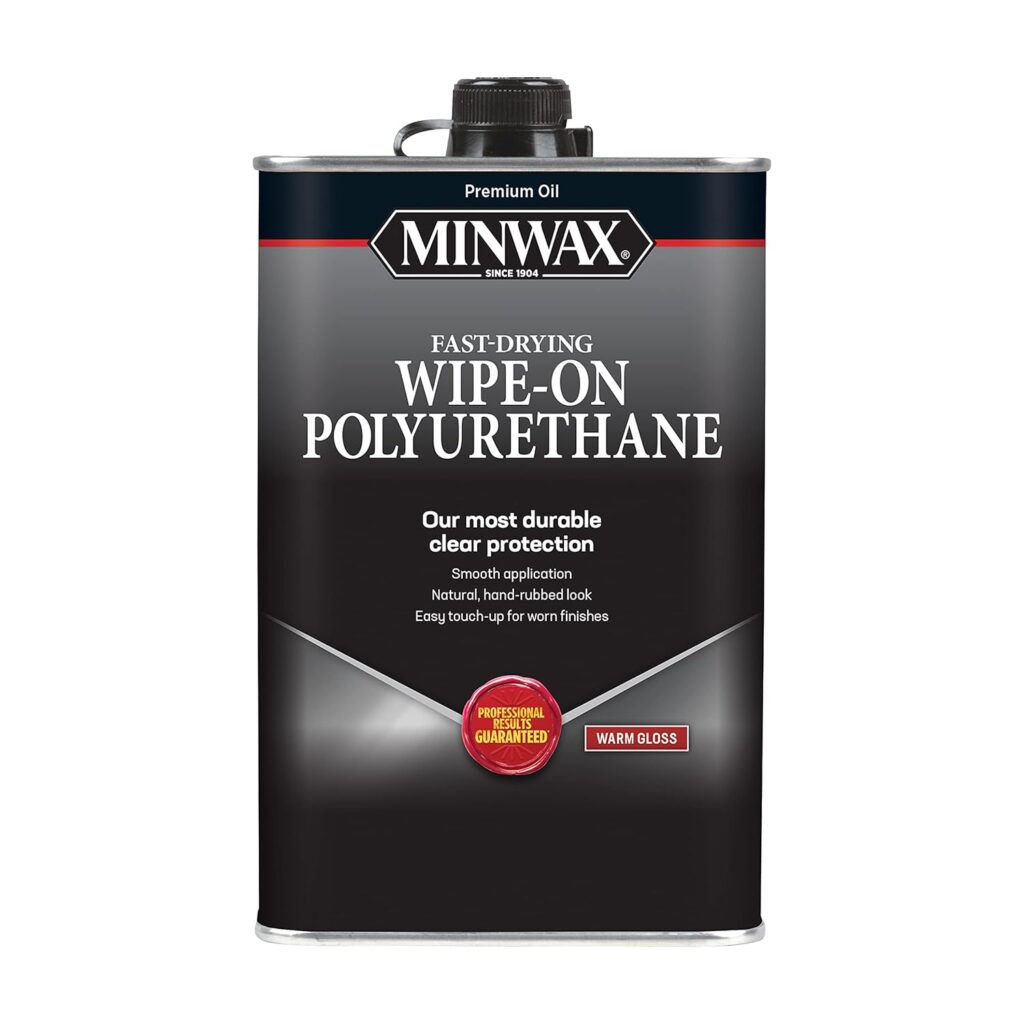
There isn’t much point in me going through oil-based finishes like Polyurethane. As solvent-based products they do have their place and especially so for use in generally wet environments and those exposed to regular spillage, hence terms like ‘yacht varnish‘, which literally means that the finish is designed for but not limited to outdoor use. ‘Yacht’ is one of those words that says it all up front and, well, “does what it says on the can.” Depicted on just about every can you will see a deep lustrous finish in some dark hardwood and almost always in the shape of a front door where the rails meet mullions and stiles with a big shiny smile. Not too many of us like brushing on brushed-on oil-based finishes like these. They are easy enough to apply provided you have mastery. Gaining the experience in using them does take time through regular and repeated practice to get the mastery you need. Even then, things can and do go wrong. This finish takes hours to dry and needs a protective environment until it is indeed dry and cured through. I don’t want to get into something I don’t use any more though I might just be tempted to use them for a dining table they are extremely durable. The downside of using them is the clean-up of the brush. The solvent dilutes the varnish through repeated immersions until the solvent is clear. You can use a half-litre in no time at all. Now the question comes: where are you pouring the waste solvent now so polluted with both solvent and oil? This is where the US version favours what they refer to as ‘wipe-on poly’. With this version, no brushes are used. You literally rag on the finish and wipe down the excess. Apply the recommended number of coats using the same rag bagged in plastic or shrink wrap and then allow the rag to dry on the rag after the last coat and dispose of it according to the advice given by your local council. Here in the UK, you might want to make your own wipe-on poly. Simply mix mineral spirits with an equal amount of oil-based polyurethane (PU). Apply with a rag as a wipe-on wipe-off and reapply many coats until you have the build-up and look you are looking for. This will be much less costly than buying wipe-on finishes and a single rag will squeeze out as needed and can be bagged between coats. Applying the finish thinned like this also reflects in the drying time as the solvent evaporates quickly and means coat contamination from air-borne dust is greatly reduced. The main advantage of wipe-on finishes is the reduction of waste and then contamination elsewhere. That is also why I like this next finish.
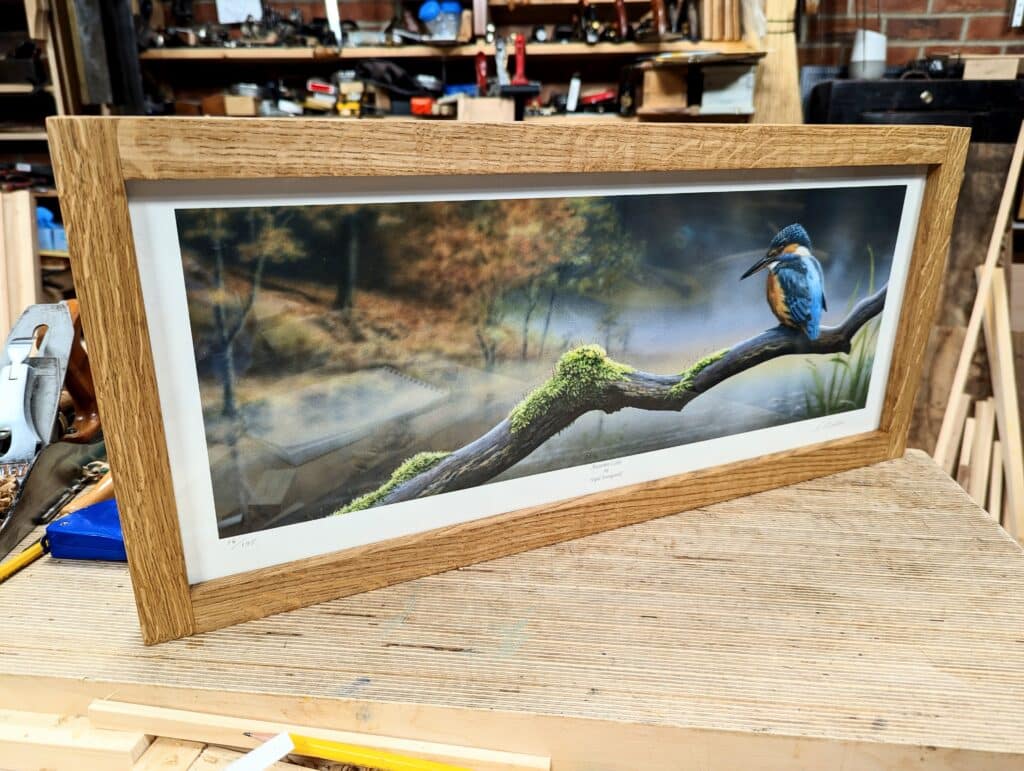
I just finished yet another picture frame this morning. By finished I mean I applied the last coat of something called oil. It is a solvent-based finish with a difference. I have to say I love everything about but I especially love the final feel and then the feel in between coats too. It’s one of those rare finishes you might consider stopping at just one coat. Even at this level, you will get the depth of colour oil finishes give you but without any oiliness. The finish I used is manufactured by the German-based company Osmo. 2.5 litres (just over half a gallon) cost just over £100 and that seems expensive but when you consider its economy of application you might want to reconsider this. Coverage is 24 m²/L. I understand that to be 24 m2 per litre so in essence, in the description, one litre of the finish will cover approximately 24 square meters with 2 coats and that is a massive area of wood whether a floor area or in picture frames. Additionally, wastage is incredibly low because you apply the finish and then wipe it down to a super thin level. You can squeeze out the residue or apply it elsewhere on your project as needed.

I have made a dozen or so picture frames of this design from scratch to date and then helped Hannah with her order for 21 of them. I designed the frames to cater to hand toolists. It eliminates the need for any machine work if that is what some want. The ones `i just made are for my most recent video and blog offerings. I will be going into the video and blog shortly but for now, I will focus on this particular finish.
With many things finish, you often have to see what is not said to see what is. If it doesn’t say spirit-alcohol proof in the list of ‘proof’ positives then it will not be spirit-alcohol proof in the full measure of it. That does not particularly bother me but it might to your specific customer. It is important to add here that this is likely one of the easiest finishes to recoat and fix flaws in indiscernible.
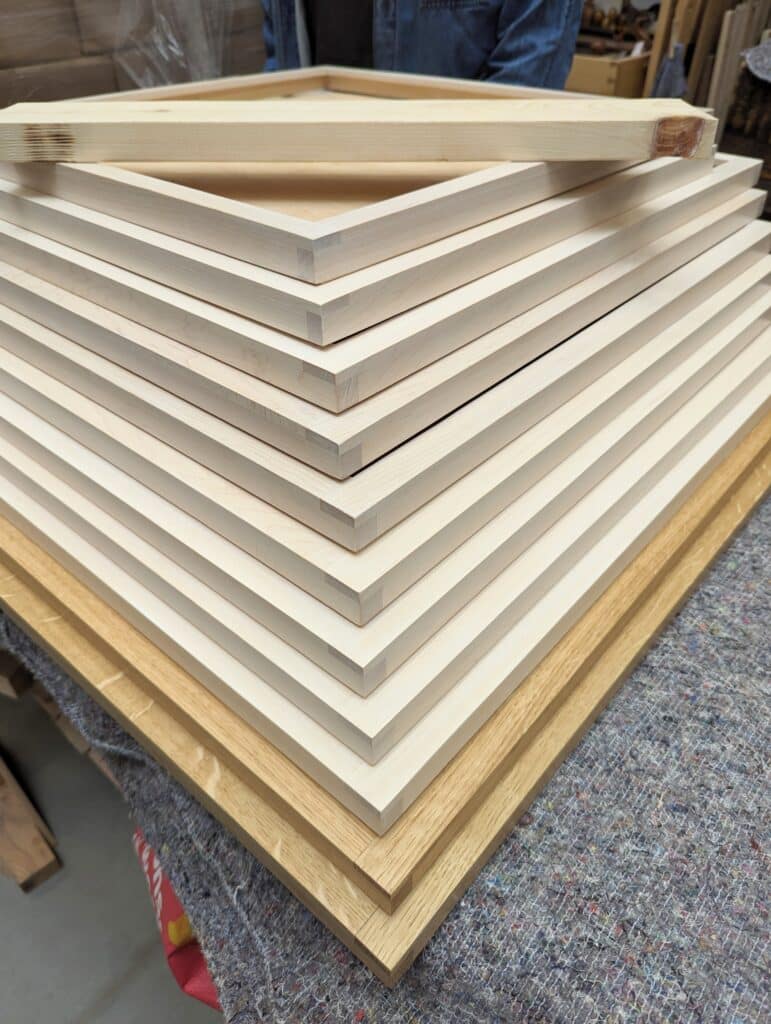
Frames can be pernickety as can most small and multifaceted pieces with internal corners and six surfaces per stem. I did not particularly follow the maker’s guidelines but I did adapt my choice of applicators according to project type and size. For my frames, I just used a folded paper towel as the applicator and then too for my wipe-off ‘cloth’. This is a clean way of working as long as you use a better grade of paper towel and not a cheapo. On larger surfaces, I rely on a 4″ sponge roller to apply the finish and then a squeegee (the type used for window cleaning) to remove the excess back into the jar I decanted into. Once done I wipe along or with the grain to give the even sheen it results in.
This finish is very surprising. I have yet to find it raise the grain as do many finishes. After that first coat I use a fine-grade mesh abrasive to skim the surfaces and this results in a super-smooth finish. that’s the last time I do this. Subsequent coats need no such abrading and the outcome is a full and even surface coating. The drying and curing time is almost the same as other oil-based finishes but without the liquidity that so suffers with atmospheric pollutants like dust and with each coat applied. My shop is far from a dust free environment and yet I have had no issues with the surface showing any signs of nibbing caused by particles of dust and such.
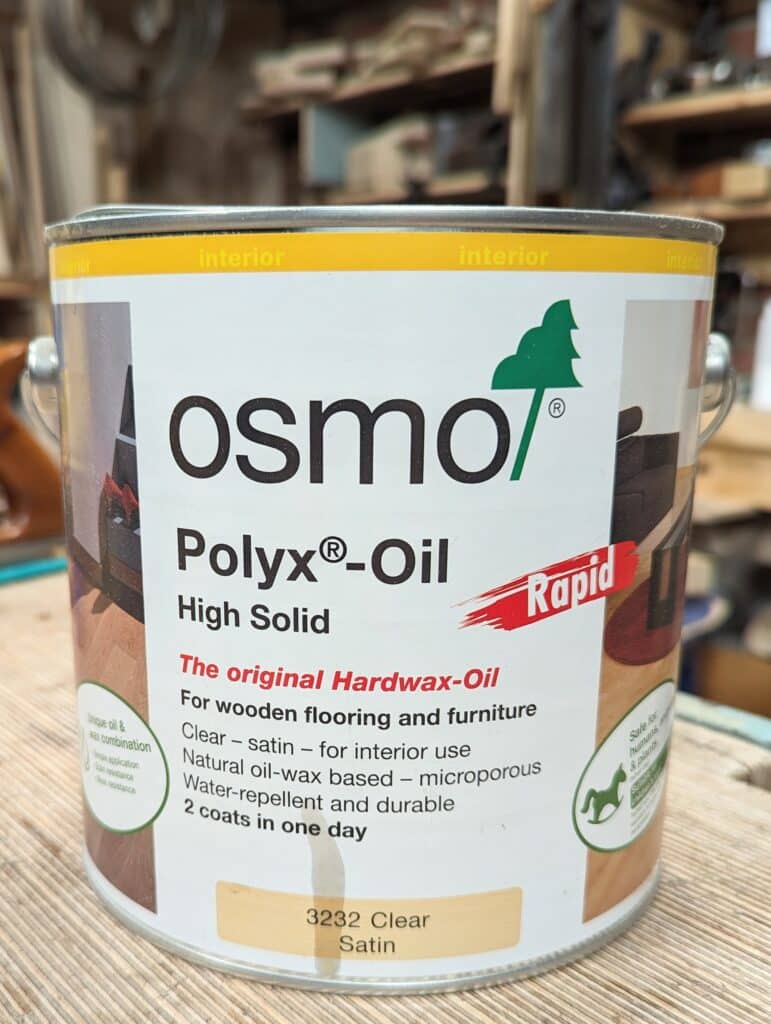
I generally do not advertise the product manufacturers I use. I want my site and my reputation to be clean and free from outside influences. So let me add my usual disclaimer here and that is that I do not take any sponsorship, product or kickbacks from anyone full stop. Osmo Polyx Oil High Solids in Satin is a really positive finish. Going off their list of product aims and claims, I took the following:
Osmo polyx hard wax-oil rapid satin is a clear, fast drying, finish suitable for everything from wooden floors and can also be used on Cork and for the treatment of furniture surfaces (i.e. Table tops). The finished surface is durably tough and hard-wearing and is water-repellent and dirt-resistant. The finish is resistant against wine, beer, cola, coffee, tea, fruit juices, milk and water etc. What the etc is I don’t know. When dry according to DIN 68861 – 1C (German industrial Norm). dirt can easily be removed without trace. Renovating, even partially, is easy. Just clean and re-treat worn areas: no sanding, no repair marks, no removal of previous polyx-oil finish. The wear resistance of floors treated with Osmo polyx-oil even exceeds that of conventional parquet seals and varnishes.
With regard to special applicators. You really don’t need much at all. Polyester microfibre cleaning cloths work well for larger areas for both wiping on and wiping off, regular paint brushes for inner corners and fiddly moulds work well followed up with the microfibre cloth for wiping off and then paper towel on small projects do well too.


Thanks Paul. I have been using shellac mostly for all the reasons you mention. Christian Becksvoort, for his cherry furniture, wrote an article in Fine Woodworking about his preference for Tried and True linseed oil based products. I’ve been happy with it and as a chemist I think it is a relatively safe finish to use; shellac also is a safe finish. Most of the others, I don’t care for for a variety o reasons.
I will give Osmo a try to see what it is like. At some point, I need to make an entertainment center which will essentially be two big China cabinets with a smaller low cabinet in between. Given the surface area of wood for this entertainment center, ideally I want to use something that is relatively easy to apply and requires minimal coats. Osmo may be that finish. Will try on a smaller piece first.
Well, I have yet to find its equal including tried and true.
Paul
Any experience in putting the Osmo on top of shellac? I have a small table that I finished with shellac about 10 years ago and it’s time to update the finish.
From what I understand you need a “raw” wood surface for Osmo. So no shellac or oil based stains before applying it. I’ve used Osmo recently on a cherry credenza and love the look,feel and ease if use.
I have actually put Osmo on top of Shellac with good results. It was only a single coat of shellac which was then sanded – only to raise the grain. I use this technique with other oils (like Kunos Oil). However, as Paul said, Osmo doesn’t really seem to raise the grain itself, so I have stopped using shellac first and just go straight in with the Osmo 🙂
And you should really use the dewaxed shellac if used as any base sanding sealer too, everyone.
Thanks Paul for this feedback. Very much looking forward to trying Osmo.
Joe,
I’ll third the recommendation for Osmo (like you need anything beyond Paul’s recommendation). Interestingly, I came by Osmo via one of those YouTube types that recommend the heavy bar clamps (see Paul’s last post), along with heavy planes and expensive chisels. It shows that they do get some things right, as I’ve not been disappointed with the Osmo finishes at all. Expensive, but good value. Hope your entertainment centre is a success!
Rico
Hello Paul,
hope, your hand gets better and better🙏
Thank you for this article which focused me again to shellac.
I looked up the German homepage of Osmo. There it is written that the coverage is 1 Liter to 24 squaremeters. But you can make 2 coats a day because of the fast drying time. I hope that clears it up.
Best wishes from Hamburg, Germany🙋🏼♂️
It is not fast drying if you need five hours between coats no matter what the manufacturer says so lets settle that. fast drying would usually be within minutes and no more than an hour. ‘Faster’ drying might,just might be a more accurate term. We should never accept maker’s terms for describing their products. Not sure where you focussed on my hand, Lothar, theyr are and always have been working great. I had minor surgery six months ago that held me up for only a day or so. Could you mean that? Anyway, thank your your wellwishing.
I use both t&t varnish oil and osmo polyx-oil on my fine furniture creations. both are low voc and best applied with 2 rags – one to wipe on and the other to wipe off. both need paint thinner to remove from hands & brushes. osmo is less viscous than t&t and thus spreads thinner, faster and more sparingly.
I like 2 coats with an overnight between them. osmo leaves a waxed finish while t&t leaves an oil finish that then needs a coat of wax to get a buffable surface. osmo is nearly 2x the cost of t&t and both are readily available on Amazon.
I’m migrating to osmo as I like the wax finish but still use t&t for some projects due to cost.
Hello Paul and team,
thank you for all this informations, it’s help me a lot.
Do you know this product : Hassui Ceramic ?
It’s seems to be good to but, the price it’s very high !
Thank you again.
Cheers,
Ludovic
Regarding making your own “wipe on poly” in the UK… is “mineral spirits” what we would call “white spirit”?
Thanks,
Matt
It is used just the same with the same purpose, Matt.
Thanks Paul.
Hello Paul, I recently made a wall shelf for one of my grandsons and used Tried and True for a finish and I liked the result. A second shelf for his brother was requested and so this time I purchased a 750 ml can of OSMO hard wax oil clear and wiped it on with a product recommended by the representative which was a 1500 grit sanding pad. The wood (Shedua) easily absorbed the product and after a second coat a day later looked beautiful. JMHO, this is my preferred product going forward because of ease of application as opposed to other finishes that I have tried. NO cleanup!
Richard.
If you spilled all those chemicals on a finished surface Paul, I’d be worried that I am gettin g clumsy.
The beach floor in our living room and kitchen area was treated with Osmo hard wax oil (not Polyx-oil). Very good experience with it. Nice sheen and easy to maintain with a special product from Osmo. Do not use soap or detergents. After some years, the kitchen area didn’t look so nice any more. No worries. Take a steel wool (medium rough) and now use a detergent. The finish can nicely and evenly be removed completely. Let it dry. Just apply a new layer of Osmo,wait 24 hours and apply the 2nd layer.
The advantage of this product is that you don’t need to fix the whole area (floor in this case). The product easily blends in with an area already done.
Hi Paul
I’m in the middle of building your trestle dining table now offered on your Masterclasses website. I’ve used Waterlox on other projects that need a durable finish but it’s pretty potent stuff to work with in a small shop, and the dry time is long. I’d like a durable alternative and this Osmo Poly-x oil seems to be the ticket.
Would you recommend Osmo for the trestle dining table top, and how does the appearance of the Osmo poly-x oil finish compare with three coats of blonde shellac buffed out with beeswax polish? I don’t think one can beat the appearance of the shellac buffed out with wax, but it isn’t durable enough to a tabletop.
The reason I ask is because I have a chest of drawers that I built that will be next to the trestle dining table which has the blonde shellac/beeswax finish. Be nice if the finishes matched.
Thanks
Paul, I found your article to be both interesting and informative. Many of the things you pointed out I have not heard before. Also, your points on cleanup and pollution are well taken.
Shellac has always worked well for me, and wipe on poly when water resistance is needed. I did not realise the hazards of water based finishes until now and I plan on staying away from them, but alas it seems all of us are already infected with very tiny pieces of plastic, even our brains. In the future there will have to be a method to rid our planet of even the tiniest pieces of pollution. It could be figured out now but big business will not allow that to take place, profits are more important. I am not being cynical because I know it will be addressed in what is called the “ new system “. Label me a fool?
I think that we all know all the more and we must make individual choices to start cutting now but we must do it without the self-righteousness used these days as justification for intimidation. Ironically, though we all have a right to free speech and protests, when someone uses CA glue to glue themselves to towers, roads and bridges they are using cyanoacrylate glue which is composed of an acrylic resin. The main ingredient in cyanoacrylate glue is cyanoacrylate, which is an acrylic monomer that transforms to a plastic state after curing.
Just waiting for that “new system” Jim
If it seems I was being self righteous I n my hopes for the future I apologise.
I certainly wasn’t referring to anything you said, Jim. Not at all. I do see issues in realms where that happens considerably more than ever with political agendas that stymie free speech and other points of view. Hopefully we DO feel as you in hoping for a better future.
i really dont understnd why protesters are throwing oil on the paintings of the Old Masters and other classic works of art. really seems counterproductive. they say there is no such thing as bad press but i really hate these vicious acts. throw the oil on the oil execs not public treasures!
I use PURE Tung oil, has to be pure, no hydrocarbon thinners, that ruins the process. To thin, recommended for the first coat, use Citrine, a citrus derivative.
Use any number of coats, wipe on with a rage, allow to penetrate ,wipe off excess after 1 hour and leave over night, apply he next cost 24 hours after the first, etc.
Allow to harden for a couple of days before use. It hardens by chemical process NOT evaporation!
The result is an excellent waterproof hard surface, not glossy though, if you want gloss use something else.
I use it on all my furniture, it gives marvelous highlighting of good grain. Try it but be careful, some of the major paint suppliers advertise “Pure Tung Oil” but it often contains hydrocarbon thinners, not the real stuff!! Avoid it.
Wow! Quite a complicated, lengthy and labour intensive process.
The traditional oil finish on violins isn’t tung oil, but it’s a long process as well. Stradivari apparently left his on the roof to cure, because there exists a letter of apology from him to a customer explaining that his instrument was delayed due to rainy weather.
I have never suggested that violin varnish is made from tung oil. I would never use tung oil on anything myself so not sure where that came from. Generally, we use a specially made varnish made from tree resins and without solvents. In that case there is no other way to dry the varnish, which wouldnever be touch dry for years, but to expose it to the UV rays from the sun or UV lights. Strad had no access to the alternative in his day so the roof wood give him adequate access to days of uninterupted sunshine to cure the built-up coats in layers of his varnishes.
I am going to try this, a couple of my friends swear by it. They say the extra effort and time is really not a big deal and is totally worth it.
Thanks for this – hands on & practical experience dispels a lot of “finishing fog”. I’ve been using Liberon finishing oil for years, same approach as Osmo, on elm it really brings out the depth of colours and grain. Has anyone tried both Osmo and Liberon – i’d be interested to know if there is much difference between them. Thanks S
I always appreciate your unvarnished (pun intended) comments and recommendations. I discovered you on YouTube with your first workbench video built in your backyard. It was there I learned about knifewalls, how to hold and use a square, how to chop a mortice and so much more. My world is a better place because of you.
Dear All,
Here in the US, Rubio’s Monocoat is all the rage. It is also a hard wax finish. When compares to Osmo, they are nearly identical. The largest difference is the base oil used. Rubio’s uses polymerized linseed oil as opposed to, if I recall correctly, safflower oil in Osmo.
I prefer Rubio’s for something like quartersawn white oak. It makes the medulliary rays pop. Osmo leaves the coloring about the same as the raw wood. However, I did not try ammonia fuming the oak before applying Osmo.
My 2 cents.
Paul
Thanks for your comments about Osmo. I started using it 3 years ago and that has become my “go to” for any furniture that may be exposed to food or beverage. Occasionally have combined using different finishes on different parts of a project. I recently made another one of your 3 legged floor lamps as a house warming gift for a friend-I used shellac for the majority of the woodwork (like the higher gloss on the quartersawn Oak) but then used Osmo for the small table.
Jeff
I’ve been using OSMO #3043 for several years now as a fiish for my furniture. I use a gray nylon scrubby to apply the first coat then switch to white scrubby for additional coat or two. Also use it on picture frames as well and recently used Real Milk Paint and sealed them with the OSMO — great stuff! Here’s a link to my post: https://wordpress.com/post/woodworksbyjohn.com/8775
One problem here in the USA is that formulions change due to EPA requirements. Case in point is Watco’s Danish Oil, in the 1980-1990’s they changed so much that I quit using it! It used to be my go to finish for all of my work and part of a 3 part top coat but the changes made were terrible.
Very informative article. I have used most of the finishes you listed but my favorite by far is oil. I have not tried the hardwax oil yet but will need to give that a try. My favorite method of application is to use a small square of fine abrasive mesh pad to apply the oil.
Great info, I’ve learned something today. Thanks
I was surprised that you didn’t mention boiled linseed oil. I guess it’s because you were addressing furniture, not tool handles. Most of my “woodworking” in the past couple of years has been in resurrecting old tools – hand planes, an old wooden spokeshave, and the handles of two old backsaws, a . I’ve made a tote and knob for one old SB No7, and refinished all the totes and knobs on several other planes. After scraping them down and sanding them, I’ve used several coats of BLO on all of them, and I really love the look of those tools, and the feel of the wood.
I’ve not yet made much of what anyone would call “furniture” – just three small Bhuddist shrines for my wife and two of my children. One oak, one poplar, one cedar. I hate working with cedar, but that was the requested wood. They were simple affairs, not involving any difficult joints, but they came out pretty well. For a finish, I used something called Watco Danish Oil (teak) on all three. It’s now a Rust-Oleum product. I really like the way it looks, a warm, honey color – it’s easy to wipe on with a rag, and I can apply several coats in rapid succession. Two things that I DON’T like: (1) It can take a week or more to fully cure and stop smelling; Rust-Oleum claims it has low VOCs, but I doubt that – I haven’t noted anyone else complaining about its smell, but to me it’s very strong, and not very pleasant. (2) It doesn’t seem to do the one thing they tout it for – protect from water stains; on one of the butsudans, after three coats of Danish Oil and having cured for several days, condensation from a cold beverage (grandkid) stained the finish. However, all three of them still look very good, and it really is an easy-to-apply finish.
BLO is very much a us thing and everyine swears by it there. Personally, I will probably never use it again as there as are so many better finishes to work with. Danish oil is not an oil but whatever any manufacturer wants to mix in a bucket and sell as Danish oil. Denmark has nothing to do with the mixing and blending of Linseed oil and/or Tung oil, mineral spirits, synthetic resins and varnish that then contaminate the atmosphere you live in for weeks and months and sometimes years with outgassing as it cures. No matter the maker, Danish Oil is a solvent-based product. All finishes are described as ‘nourishing wood products.’ This sounds good, as though you are somehow, ‘feeding’ the undernourished material. Product makers are as disingenuous as they ever were. A dining table may not look as good if you used it without any protective coating on it but it would not break down and crumble into rot if you did nothing at all to it once it was made. “Protective” just means cleanable or wipable and does not nourish or increase the lifespan of the piece of furniture. Oh, and don’t forget that a wadded up rag of boiled linseed oil (BLO) can and often enough does spontaneously combust so make sure you dispose of this product in the proper manner and don’t leave a rage lying around somewhere.
Thank you, Paul, for the rapid and in-depth response. I do recognize that BLO would be a poor finish for furniture. As for tool handles, I grant you that I use it as much from family tradition as anything else – I’m 80, and I’ve been using it for about 64 years. My father and his dad used it, so it’s been our go-to for over 100 years. Are there better finishes? From your criticism and disdain, I’d guess there may well be. But to tell the truth, the look and feel of BLO on the handles of my planes and saws seems good, to me. I know BLO doesn’t prevent gradual darkening…when working, my hands often carry remnants of grunge. The handles show the effects of time and use – I don’t mind. They are old friends, aging along with me, but still strong, soft, and natural-feeling in my hands. I rub on another coat of BLO every so often. I tried shellac, but didn’t care for the slick feel of it. Even if I were sure there is better finish…I likely wouldn’t change. My children, or theirs, can do that when I can no longer use my tools.
However, I do appreciate your comments on “Danish Oil”. As you point out, it is certainly the off-gassing of solvents that created the unpleasant (and long-lasting) smell that I found so offensive. I will dispose of the half-can I have left, and good riddance.
For any future non-tool projects, I’ll experiment with shellac (with and without added stain) and the Osmo product you described. I’ll try the harder “floor varnish” on a table-top (thanks for your multi-use suggestion). A friend and I are planning to make several tool totes – for ourselves, but mainly for our children and grandchildren – we will likely use the floor varnish for a wear-resistant finish, so again, thanks for the idea.
Again, I truly appreciate the time you take to answer all our questions so carefully and fully. Being a hardheaded contrarian, I may not always agree with you, or heed your advice, but I treasure it nonetheless. And I am very glad to read that your recovery is progressing well. God bless you, sir.
I looked up the ingredients and found them on the Osmo Canada web site.
“INGREDIENTS
Solid ingredients: Based on natural vegetable oils and waxes (sunflower-oil, soybean-oil, thistle-oil, carnaubawax, candelilla wax), silica, siccatives (drying agents).
Naphtha (petroleum), hydrotreated heavy (disaromatized, benzenefree). Complies with Environment Canada VOC regulations (SOR/2009-264). Detailed declaration of ingredients available upon request.”
And on their Material Safety Data Sheets it says this:
“Dangerous components:
64742-48-9 aliphatic hydrocarbons, C10-C13 Asp. Tox. 1, H304; Flam. Liq. 4, H227 30-60%
Additional information: 94/69/EC (21st ATP). The benzene content of the product is less than 0.1%.
Classificatin or labeling as carcinogenic is not necessary.”
“After skin contact: Immediately wash with water and soap and rinse thoroughly.”
Just for everyone’s information.
U.S. supplier says that Osmo 3232 is only available in Europe.
I’ve used T&T and wax somewhat happy with the results. I an always on the lookout for someone else’s experience with non toxic finishes so I decided to try and buy the Osmo you show in this blog. Well here in the states it doesn’t appear to be made anymore. Closest I could find was the 3054 which is the rag applied version.
Just wanted to give anyone here in the states a heads up on which one we can buy.
As alway Paul, thank you for your honesty and integrity!
Doug in New Hampshire
Has anyone compared Osmo to something like linseed oil and a paste wax finish? I always figured the finish would be similar.
Absolutely we have. There is no realcomparison between these and I might consider linseed oil as the least protective of all finishes even though in the USA it is often extolled as the only finish people would use. I like that some makers have pushed the boundaries with positive interest for a better product and Osmo is indeed one of them. archaic products. Some others swear by finishes as paste waxes but they offer only the most minimal of protection. We must see protection for what it is: mostly it is an easy-to-clean and wipe finish that resists staining, Simple! But then what we really want is a finish that is easy to apply and I see no finish anywhere that gives the highest level of protection combined with ease of application. The Osmo can be applied by brush, cloth, paper towel, roller or spray. The advantage of applying with a brush is getting into corners and moudings, but the downside is clean up. You must use mineral oil or white spirit as a solvent to clean the brush. This is somewhat messy. But with the brushing on you are not yet done. You must go in with a dry cloth to really rub off any and all excess finish.This is critical to establishing that berautiful lustre Osmo is known for. It might sound like a big deal but it really is not. Cloth applying enables you to draw out the finish and spread it as widely as possible so you minimise the waste to near zero. the second, dry-cloth wipe is perfection itself. Pure linseed oil doesn’t dry for days and even weeks. You have to use boiled linseed oil BLO. Even so, I would regard this as more an archaic finish with minimal protection quality. I’ve never liked basic wax finishes except for buffing out other finishes like Shellacand water-based clear varnishes.
I missed this reply. Thank you for taking the time to respond. I will give osmo a try as it seems to be a better finish than other oil finishes, I’ve used. Mainly tried and true or tung oil.
I once finished a cane with (based on your masterclass video) for my father with tung oil. I had to wait 3 weeks to give him the cane while the finish cured.
I love Tried & True. It feels nice and I have some pieces that are 7 years old and the finish has held up very well. Osmo is way too expensive, at least here in America.
In some of the videos Mr. Sellers has said to use linseed oil, I wonder why he is saying otherwise now. And what is so bad about tung oil?
You must have the wrong man, John C. I have never in my whole lifetime used linseed oil on a single stick or stem of my furniture and never will. I have used it for tool handles but not because its good but just because it’s traditional. Ounce for ounce and the thinness of Osmo oil in three or four buillt up coats I doubt that it is any more expensive than any other finish and especially waterbourne finishes.
I see, thank you for clarifying.
When I learned from Paul about shellac and denatured alcohol I thought it was a great alternative to polyurethane finishes, which were all I had known in my earlier years. Just when I thought I had shellac figured out, here in California the state’s air resources board banned the sale of denatured alcohol over concerns about its impact on air quality. I find it hard to believe that retail sales of denatured alcohol can be that harmful to air quality, but maybe there are industrial uses I’m not aware of. Zinsser says ammonia can be used to clean up instead. I’ve been trying that and it works ok (if a little acrid) for the stuff out of a can, but it’s clearly not viable for mixing up my own solutions from shellac flakes, which I’d like to try some day. I’m not quite sure what to do about that. Medical grade alcohol is available on the web, and it might be pure, but it ain’t cheap. Still scratching my head over this. If anyone has recommendations, I’m all ears. I tried Osmo a couple years ago when I made one of Paul’s keepsake boxes as a wedding present for my nephew. Maybe I did something wrong, but it took a loooooooong time to dry.
Enjoyed reading your lastest blog as always !
Having used Osmo hard wax oil, I do find it quite slow drying and now tend to use either Fiddes or Gilboys hard wax oils both are quicker drying, cheaper, made in the uk and give excellent results.